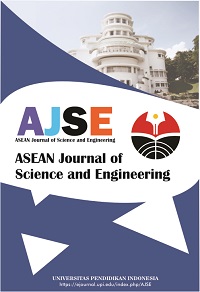Assessment of Air Quality Using the Plume Air Quality Index Indicator (PAQI): Reference to Five Towns in Nigeria
Abstract
Keywords
Full Text:
PDFReferences
Abegunrin, T. P., and Sangodoyin, A. Y. (2016). Development of a rainwater tank sizing calculator for rainwater harvesting application in Southwest Nigeria. International Journal of Engineering and Technology, 6(5), 166-174.
Abulude, F. O., Ogunmola, D. N., Alabi, M. M., and Abdulrasheed, Y. (2017). Museums and monuments in Nigeria: reducing pollution damage. Continental Journal Applied Sciences, 12(3), 42-56.
Abulude, F. O., Ogunmola, D. N., Alabi, M. M., and Abdulrasheed, Y. (2018). Atmospheric deposition: Effects on sculptures. Chemistry International, 4(2), 136-145.
Akinfolarin, O. M., Boisa, N., and Obunwo, C. C. (2017). Assessment of particulate matter-based air quality index in Port Harcourt, Nigeria. Journal of Environmental Analytical Chemistry, 4(4), 1-4
Beelen, R., Raaschou-Nielsen, O., Stafoggia, M., Andersen, Z. J., Weinmayr, G., Hoffmann, B., Wolf, K., Samoli, E., Fischer, P., Nieuwenhuijsen, M., Vineis, P. and Hoek, G. (2014). Effects of long-term exposure to air pollution on natural-cause mortality: an analysis of 22 European cohorts within the multicentre ESCAPE project. The Lancet, 383(9919), 785-795.
Cohen, A. J., Brauer, M., Burnett, R., Anderson, H. R., Frostad, J., Estep, K., Balakrishnan, K., Brunekreef, B., Dandona, L., Dandona, R., and Forouzanfar, M. H. (2017). Estimates and 25-year trends of the global burden of disease attributable to ambient air pollution: an analysis of data from the Global Burden of Diseases Study 2015. The Lancet, 389(10082), 1907-1918.
Cromar, K. R., Ghazipura, M., Gladson, L. A., and Perlmutt, L. (2020). Evaluating the US Air Quality Index as a risk communication tool: Comparing associations of index values with respiratory morbidity among adults in California. PLoS One, 15(11), e0242031.
Hoek, G., Krishnan, R. M., Beelen, R., Peters, A., Ostro, B., Brunekreef, B., and Kaufman, J. D. (2013). Long-term air pollution exposure and cardio-respiratory mortality: A review. Environmental Health, 12(1), 1-16.
Jayamurugan, R., Kumaravel, B., Palanivelraja, S., and Chockalingam, M. P. (2013). Influence of temperature, relative humidity and seasonal variability on ambient air quality in a coastal urban area. International Journal of Atmospheric Sciences, 2013, 1-8.
Kanchan, A. K. G., Goyal, P., Benitez-Garcia, S. E., Kanda, I., Okazaki, Y., Wakamatsu, S., Basaldud, R., Horokoshi, N., ortinez, J. A., Ramos-benitez, V. R., and Azuchi, F. A Review on Air Quality Indexing System. Asian Journal of Atmospheric Environment, 9(2), 101-113.
Osimobi, O. J., Yorkor, B., and Nwankwo, C. A. (2019). Evaluation of daily pollutant standard index and air quality index in a university campus in Nigeria using PM10 and PM2. 5 particulate matter. Journal of Science, Technology and Environment Informatics, 7(2), 517-532.
Wambebe, N. M., and Duan, X. (2020). Air quality levels and health risk assessment of particulate matters in Abuja municipal area, Nigeria. Atmosphere, 11(8), 817.
Ward, A. L. S., and Beatty, T. K. (2016). Who responds to air quality alerts? Environmental and Resource Economics, 65(2), 487-511.
Xu, K., Cui, K., Young, L. H., Wang, Y. F., Hsieh, Y. K., Wan, S., and Zhang, J. (2020). Air quality index, indicatory air pollutants and impact of COVID-19 event on the air quality near central China. Aerosol and Air Quality Research, 20(6), 1204-1221.
Zagha, O., and Nwaogazie, I. L. (2015). Roadside air pollution assessment in Port. Harcourt, Nigeria. Scientific Research and Essays, 3(3), 66-74.
DOI: https://doi.org/10.17509/ajse.v3i3.48255
Refbacks
- There are currently no refbacks.
Copyright (c) 2022 Universitas Pendidikan Indonesia

This work is licensed under a Creative Commons Attribution-ShareAlike 4.0 International License.












